Fast and Slow Earthquakes in Alaska: Implications from a Three-Dimensional Thermal Regime and Slab Metamorphism
Abstract
Featured Application
Abstract
1. Introduction
2. Methods and Models
3. Results
3.1. Three-Dimensional Slab Thermal Regime
3.2. Slab Water Content Variation
4. Discussion
4.1. Subduction Thermal Regime and Earthquakes
4.2. Slab-Derived Fluids and Earthquakes
4.3. Fast and Slow Earthquakes in Major Subduction Zones
5. Conclusions
- (1)
- The metamorphosed and downgoing oceanic crust containing bound water releases a large amount of fluid, which results in the recurrence of fast and slow earthquakes beneath south-central and southwestern Alaska by elevated pore fluid pressure and hydrofracturing.
- (2)
- The seismic transition zone and the slow slip events (SSEs) identified beneath the Upper Cook Inlet coincide with the slab metamorphic dehydration regions.
- (3)
- The slow earthquakes observed beneath Alaska with quasi-stable fault slip preferentially occur, accompanied by high dehydration and temperatures. Fast earthquakes occur updip along the dehydration zones under conditionally low temperatures and dehydration.
Supplementary Materials
Author Contributions
Funding
Institutional Review Board Statement
Informed Consent Statement
Data Availability Statement
Acknowledgments
Conflicts of Interest
References
- Martin-Short, R.; Allen, R.; Bastow, I.D.; Porritt, R.W.; Miller, M.S. Seismic imaging of the Alaska subduction zone: Implications for slab geometry and volcanism. Geochem. Geophys. Geosystems 2018, 19, 4541–4560. [Google Scholar] [CrossRef]
- Li, Z.H.; Gerya, T.; Connolly, J.A. Variability of subducting slab m-orphologies in the mantle transition zone: Insight from petrological-thermomechanical modeling. Earth-Sci. Rev. 2019, 196, 102874. [Google Scholar] [CrossRef]
- Zhao, D.; Christensen, D.; Pulpan, H. Tomographic imaging of the Alaska subduction zone. J. Geophys. Res. Solid Earth 1995, 100, 6487–6504. [Google Scholar] [CrossRef]
- Qi, C.; Zhao, D.; Chen, Y.; Ruppert, N.A. New insight into the crust and upper mantle structure under Alaska. Polar Sci. 2007, 1, 85–100. [Google Scholar] [CrossRef][Green Version]
- You, T.; Zhao, D. Seismic anisotropy and heterogeneity in the Alaska subduction zone. Geophys. J. Int. 2012, 190, 629–649. [Google Scholar]
- Wei, S.S.; Ruprecht, P.; Gable, S.L.; Huggins, E.G.; Ruppert, N.; Gao, L.; Zhang, H. Along-strike variations in intermediate-depth seismicity and arc magmatism along the Alaska Peninsula. Earth Planet. Sci. Lett. 2021, 563, 116878. [Google Scholar] [CrossRef]
- Eberhart-Phillips, D.; Christensen, D.H.; Brocher, T.M.; Hansen, R.; Ruppert, N.A.; Haeussler, P.J.; Abers, G.A. Imaging the transition from Aleutian subduction to Yakutat collision in central Alaska, with local earthquakes and active source data. J. Geophys. Res. Solid Earth 2006, 111, B11303. [Google Scholar] [CrossRef]
- Jadamec, M.A.; Billen, M.I. The role of rheology and slab shape on rapid mantle flow: Three-dimensional numerical models of the Alaska sl-ab edge. J. Geophys. Res. Solid Earth 2012, 117, 338–341. [Google Scholar] [CrossRef]
- Martin-Short, R.; Allen, R.M.; Bastow, I.D. Subduction geometry beneath south central Alaska and its relationship to volcanism. Geophys. Res. Lett. 2016, 43, 9509–9517. [Google Scholar] [CrossRef]
- Finzel, E.S.; Trop, J.M.; Ridgway, K.D.; Enkelmann, E. Upper plate proxies for flat-slab subduction processes in southern Alaska. Earth Planet. Sci. Lett. 2011, 303, 348–360. [Google Scholar] [CrossRef]
- Abers, G.A.; Nakajima, J.; van Keken, P.E.; Kita, S.; Hacker, B.R. Thermalpetrological controls on the location of earthquakes within subducting plates. Earth Planet. Sci. Lett. 2013, 369, 178–187. [Google Scholar] [CrossRef]
- Zhao, D.; Yu, S.; Liu, X. Seismic anisotropy tomography: New insight into subduction dynamics. Gondwana Res. 2016, 33, 24–43. [Google Scholar] [CrossRef]
- Yang, X.; Gao, H. Segmentation of the Aleutian-Alaska subduction zone revealed by full-wave ambient noise tomography: Implications for the along-strike variation of volcanism. J. Geophys. Res. Solid Earth 2020, 125, e2020JB019677. [Google Scholar] [CrossRef]
- Smith, W.H.; Sandwell, D.T. Global sea floor topography from satellite altimetry and ship depth soundings. Science 1997, 277, 1956–1962. [Google Scholar] [CrossRef]
- Hayes, G.P.; Moore, G.L.; Portner, D.E.; Hearne, M.; Flamme, H.; Furtney, M.; Smoczyk, G.M. Slab2, a comprehensive subduction zone geometry model. Science 2018, 362, 58–61. [Google Scholar] [CrossRef] [PubMed]
- Siebert, L.; Simkin, T.; Kimberly, P. Volcanoes of the World, 3rd ed.; University of California Press: Berkeley, CA, USA, 2010; Volume 568. [Google Scholar]
- Fu, Y.; Freymueller, J.T. Repeated large slow slip events at the southcentral Alaska subduction zone. Earth Planet. Sci. Lett. 2013, 375, 303–311. [Google Scholar] [CrossRef]
- Wei, M.; McGuire, J.J.; Richardson, E. A slow slip event in the south central Alaska Subduction Zone and related seismicity anomaly. Geophys. Res. Lett. 2012, 39, 15. [Google Scholar] [CrossRef]
- Gomberg, J.; Prejean, S. Triggered tremor sweet spots in Alaska. J. Geophys. Res. Solid Earth 2013, 118, 6203–6218. [Google Scholar] [CrossRef]
- Li, B.; Ghosh, A. Near-continuous tremor and low-frequency earthquake activities in the Alaska-Aleutian subduction zone revealed by a mini seismic array. Geophys. Res. Lett. 2017, 44, 5427–5435. [Google Scholar] [CrossRef]
- Li, S.; Freymueller, J.; McCaffrey, R. Slow slip events and time-dependent variations in locking beneath lower cook inlet of the Alaska-Aleutian subduction zone. J. Geophys. Res. Solid Earth 2016, 121, 1060–1079. [Google Scholar] [CrossRef]
- Segou, M.; Parsons, T. The role of seismic and slow slip events in triggering the 2018 M7. 1 Anchorage earthquake in the southcentral Alaska subduction zone. Geophys. Res. Lett. 2020, 47, e2019GL086640. [Google Scholar] [CrossRef]
- Elliott, J.; Freymueller, J.T. A block model of present-day kinematics of Alaska and western Canada. J. Geophys. Res. Solid Earth 2020, 125, e2019JB018378. [Google Scholar] [CrossRef]
- Dragert, H.; Wang, K.; James, T.S. A silent slip event on the deeper Cascadia subduction interface. Science 2001, 292, 1525–1528. [Google Scholar] [CrossRef]
- Ohta, Y.; Freymueller, J.T.; Hreinsdóttir, S.; Suito, H. A large slow slip event and the depth of the seismogenic zone in the south-central Alaska subduction zone. Earth Planet. Sci. Lett. 2006, 247, 108–116. [Google Scholar] [CrossRef]
- Freymueller, J.T.; Woodard, H.; Cohen, S.C.; Steven, C.; Cross, R.; Elliott, J.; Larsen, C.F.; Hreinsdottir, S.; Zweck, C. Active deformation processes in Alaska, based on 15 years of GPS measurements. Act. Tecton. Seism. Potential Alsk. 2008, 179, 1–42. [Google Scholar]
- Wech, A.G. Extending Alaska’s plate boundary: Tectonic tremor generated by Yakutat subduction. Geology 2016, 44, 587–590. [Google Scholar] [CrossRef]
- Rousset, B.; Fu, Y.; Bartlow, N.; Bürgmann, R. Weeks-long and years-long slow slip and tectonic tremor episodes on the south central Alaska Megathrust. J. Geophys. Res. Solid Earth 2019, 124, 13392–13403. [Google Scholar] [CrossRef]
- Iwamoto, K.; Suenaga, N.; Yoshioka, S. Relationship between tectonic tremors and 3-D distributions of thermal structure and dehydration in the Alaska subduction zone. Sci. Rep. 2022, 12, 6234. [Google Scholar]
- Tackley, P.J.; Xie, S. Stag3D: A Code for Modeling Thermo-Chemical Multiphase Convection in Earth’s Mantle. In Computational Fluid and Solid Mechanics; Bathe, K.J., Ed.; Elsevier: Amsterdam, The Netherlands, 2003; pp. 1524–1527. [Google Scholar]
- DeMets, C.; Dixon, T.H. New kinematic models for Pacific-North America motion from 3 Ma to present, I: Evidence for steady motion and biases in the NUVEL-1A model. Geophys. Res. Lett. 1999, 26, 1921–1924. [Google Scholar] [CrossRef]
- DeMets, C.; Gordon, R.G.; Argus, D.F. Geologically current plate motions. Geophys. J. Int. 2010, 181, 1–80. [Google Scholar] [CrossRef]
- Hacker, B.R.; Abers, G.A.; Peacock, S.M. Subduction factory 1. T-heoretical mineralogy, densities, seismic wave speeds, and H2O contents. J. Geophys. Res. Solid Earth 2003, 108, 2029. [Google Scholar] [CrossRef]
- Müller, R.D.; Sdrolias, M.; Gaina, C.; Roest, W.R. Age, spreading rates, and spreading asymmetry of the world’s ocean crust. Geochem. Geophys. Geosystems 2008, 9, 8150. [Google Scholar] [CrossRef]
- Qu, R.; Ji, Y.; Zhu, W. Variations in Wedge Earthquake Distribution along the Strike Underlain by Thermally Controlled Hydrated Megathrusts. Appl. Sci. 2021, 11, 7268. [Google Scholar] [CrossRef]
- Grose, C.J.; Afonso, J.C. Comprehensive plate models for the thermal evolution of oceanic lithosphere. Geochem. Geophys. Geosystems 2013, 14, 3751–3778. [Google Scholar] [CrossRef]
- Stein, C.A.; Stein, S. A model for the global variation in oceanic depth and heat flow with lithospheric age. Nature 1992, 359, 123–129. [Google Scholar] [CrossRef]
- Omori, S.; Kita, S.; Maruyama, S.; Santosh, M. Pressure–temperature conditions of ongoing regional metamorphism beneath the Japanese Islands. Gondwana Res. 2009, 16, 458–469. [Google Scholar] [CrossRef]
- Yoshii, T. Regionality of group velocities of Rayleigh waves in the Pacific and thickening of the plate. Earth Planet. Sci. Lett. 1975, 25, 305–312. [Google Scholar] [CrossRef]
- Fisher, M.A.; Magoon, L.B. Geologic framework of lower Cook Inlet. Am. Assoc. Pet. Geol. Bull. 1978, 62, 373–402. [Google Scholar]
- Wang, Y.; Tape, C. Seismic velocity structure and anisotropy of the Alaska subduction zone based on surface wave tomography. J. Geophys. Res. Solid Earth 2014, 119, 8845–8865. [Google Scholar] [CrossRef]
- Pollack, H.N.; Hurter, S.J.; Johnson, J.R. Heat flow from the earth’s interior: Analysis of the global data set. Rev. Geophys. 1993, 31, 267–280. [Google Scholar] [CrossRef]
- Li, C.F.; Lu, Y.; Wang, J. A global reference model of Curie-point depths based on EMAG2. Sci. Rep. 2017, 7, 45129. [Google Scholar] [CrossRef] [PubMed]
- Kerswell, B.C.; Kohn, M.J.; Gerya, T.V. Backarc Lithospheric Thickness and Serpentine Stability Control Slab-Mantle Coupling Depths in Subduction Zones. Geochem. Geophys. Geosystems 2021, 22, e2020GC009304. [Google Scholar] [CrossRef]
- Ruh, J.B.; Le Pourhiet, L.; Agard, P.; Burov, E.; Gerya, T. Tectonic slicing of subducting oceanic crust along plate interfaces: Numerical modeling. Geochem. Geophys. Geosystems 2015, 16, 3505–3531. [Google Scholar] [CrossRef]
- Faccenda, M. Water in the slab: A trilogy. Tectonophysics 2014, 614, 1–30. [Google Scholar] [CrossRef]
- Hernández-Uribe, D.; Palin, R.M. A revised petrological model for subducted oceanic crust: Insights from phase equilibrium modelling. J. Metamorph. Geol. 2019, 37, 745–768. [Google Scholar] [CrossRef]
- Condit, C.B.; Guevara, V.E.; Delph, J.R.; French, M.E. Slab dehydration in warm subduction zones at depths of episodic slip and tremor. Earth Planet. Sci. Lett. 2020, 552, 116601. [Google Scholar] [CrossRef]
- Aziz Zanjani, F.; Lin, G. Double Seismic Zones along the Eastern Aleutian-Alaska Subduction Zone Revealed by a High-Precision Earthquake Relocation Catalog. Seismol. Soc. Am. 2022, 93, 2753–2769. [Google Scholar] [CrossRef]
- Wada, I.; Wang, K. Common depth of slab-mantle decoupling: Reconciling diversity and uniformity of subduction zones. Geochem. Geophys. Geosystems 2009, 10, 10. [Google Scholar] [CrossRef]
- Syracuse, E.M.; van Keken, P.E.; Abers, G.A. The global range of subduction zone thermal models. Phys. Earth Planet. Inter. 2010, 183, 73–90. [Google Scholar] [CrossRef]
- Penniston-Dorland, S.C.; Kohn, M.J.; Manning, C.E. The global range of subduction zone thermal structures from exhumed blueschists and eclogites: Rocks are hotter than models. Earth Planet. Sci. Lett. 2015, 428, 243–254. [Google Scholar] [CrossRef]
- Van Keken, P.E.; Hacker, B.R.; Syracuse, E.M.; Abers, G.A. Subduction factory: 4. Depth-dependent flux of H2O from subducting slabs worldwide. J. Geophys. Res. Solid Earth 2011, 116, B01401. [Google Scholar] [CrossRef]
- Brown, M.; Johnson, T. Secular change in metamorphism and the onset of global plate tectonics. Am. Mineral. 2018, 103, 181–196. [Google Scholar] [CrossRef]
- Abers, G.A.; van Keken, P.E.; Wilson, C.R. Deep decoupling in subduction zones: Observations and temperature limits. Geosphere 2020, 16, 1408–1424. [Google Scholar] [CrossRef]
- Katsumata, A.; Kamaya, N. Low-frequency continuous tremor around the Moho discontinuity away from volcanoes in the southwest Japan. Geophys. Res. Lett. 2003, 30, 20–21. [Google Scholar] [CrossRef]
- Miller, P.K.; Saffer, D.M.; Abers, G.A.; Shillington, D.J.; Bécel, A.; Li, J.; Bate, C. P-and S-Wave Velocities of Exhumed Metasediments From the Alaskan Subduction Zone: Implications for the In Situ Conditions Along the Megathrust. Geophys. Res. Lett. 2021, 48, e2021GL094511. [Google Scholar] [CrossRef]
- Jaeckel, K.; Bebout, G.E.; Angiboust, S. Deformation-enhanced fluid and mass transfer along Western and Central Alps paleo-subduction interfaces: Significance for carbon cycling models. Geosphere 2018, 14, 2355–2375. [Google Scholar] [CrossRef]
- Taetz, S.; John, T.; Bröcker, M.; Spandler, C.; Stracke, A. Fast intraslab fluid-flow events linked to pulses of high pore fluid pressure at the subducted plate interface. Earth Planet. Sci. Lett. 2018, 482, 33–43. [Google Scholar] [CrossRef]
- Wilson, C.R.; Spiegelman, M.; van Keken, P.E.; Hacker, B.R. Fluid flow in subduction zones: The role of solid rheology and compaction pressure. Earth Planet. Sci. Lett. 2014, 401, 261–274. [Google Scholar] [CrossRef]
- Wang, H.; Huismans, R.S.; Rondenay, S. Water migration in the subduction mantle wedge: A two-phase flow approach. J. Geophys. Res. Solid Earth 2019, 124, 9208–9225. [Google Scholar] [CrossRef]
- Arcay, D.; Tric, E.; Doin, M.P. Numerical simulations of subduction zones: Effect of slab dehydration on the mantle wedge dynamics. Phys. Earth Planet. Inter. 2005, 149, 133–153. [Google Scholar] [CrossRef]
- Liu, Y. Numerical simulations on megathrust rupture stabilized under strong dilatancy strengthening in slow slip region. Geophys. Res. Lett. 2013, 40, 1311–1316. [Google Scholar] [CrossRef]
- Jung, H.; Green Ii, H.W.; Dobrzhinetskaya, L.F. Intermediate-depth earthquake faulting by dehydration embrittlement with negative volume change. Nature 2004, 428, 545–549. [Google Scholar] [CrossRef]
- Brantut, N.; Sulem, J. Strain localization and slip instability in a strain-rate hardening, chemically weakening material. J. Appl. Mech. 2012, 79, 031004. [Google Scholar] [CrossRef]
- Stefanou, I.; Sulem, J.; Brantut, N. Dehydration embrittlement and compaction instabilities in subduction zones. AGUFM 2018, 2018, T21B-07. [Google Scholar]
- Gao, X.; Wang, K. Rheological separation of the megathrust seismoge-nic zone and episodic tremor and slip. Nature 2017, 543, 416–419. [Google Scholar] [CrossRef]
- Poulet, T.; Veveakis, E.; Regenauer-Lieb, K.; Yuen, D.A. Thermo-poro-mechanics of chemically active creeping faults: 3. The role of serpentinite in episodic tremor and slip sequences, and transition to chaos. J. Geophys. Res. Solid Earth 2014, 119, 4606–4625. [Google Scholar] [CrossRef]
- Ji, Y.; Yoshioka, S.; Matsumoto, T. Three-dimensional numerical modeling of temperature and mantle flow fields associated with subduction of the Phillippine sea plate, southwest japan. J. Geophys. Res. Solid Earth 2016, 121, 4458–4482. [Google Scholar] [CrossRef]
- Ji, Y.; Yoshioka, S.; Manea, V.C.; Manea, M.; Matsumoto, T. Three-dimensional numerical modeling of thermal regime and slab dehydration beneath Kanto and Tohoku, Japan. J. Geophys. Res. Solid Earth 2017, 122, 332–353. [Google Scholar] [CrossRef]
- Ji, Y.; Yoshioka, S.; Banay, Y.A. Thermal state, slab metamorphism and interface seismicity in the Cascadia subduction zone based on 3-D modeling: 3-D thermomechanical model for Cascadia. Geophys. Res. Lett. 2017, 44, 9242–9252. [Google Scholar] [CrossRef]
- Ji, Y.; Yoshioka, S.; Manea, V.; Manea, M.; Suenaga, N. Three-Dimensional Thermal Structure, Metamorphism and Seismicity beneath north-central Chile. J. Geodyn. 2019, 129, 299–312. [Google Scholar] [CrossRef]
- Ji, Y.; Yan, R.; Zeng, D.; Xie, C.; Zhu, W.; Qu, R.; Yoshioka, S. Slab dehydration in Sumatra: Implications for fast and slow earthquakes and arc magmatism. Geophys. Res. Lett. 2021, 48, e2020GL090576. [Google Scholar] [CrossRef]
- Suenaga, N.; Ji, Y.; Yoshioka, S.; Feng, D. Subduction thermal regime, slab dehydration, and seismicity distribution beneath Hikurangi based on 3D simulations. J. Geophys. Res. Solid Earth 2018, 123, 3080–3097. [Google Scholar] [CrossRef]
- Veveakis, E.; Poulet, T.; Alevizos, S. Thermo-poro-mechanics of chemically active creeping faults: 2. Transient considerations. J. Geophys. Res. Solid Earth 2014, 119, 4583–4605. [Google Scholar] [CrossRef]
- Hirth, G.; Kohlstedf, D. Rheology of the upper mantle and the mantle wedge: A view from the experimentalists. Geophys. Monogr.-Am. Geophys. Union 2003, 138, 83–106. [Google Scholar]
- Ranalli, G. Rheology of the Earth; Springer Science & Business Media: Berlin/Heidelberg, Germany, 1995. [Google Scholar]
- White, R.S.; McKenzie, D.; O’Nions, R.K. Oceanic crustal thickness from seismic measurements and rare earth element inversions. J. Geophys. Res. Solid Earth 1992, 97, 19683–19715. [Google Scholar] [CrossRef]
- Li, C.F.; Wang, J.; Lin, J.; Wang, T. Thermal evolution of the North Atlantic lithosphere: New constraints from magnetic anomaly inversion with a fractal magnetization model. Geochem. Geophys. Geosystems 2013, 14, 5078–5105. [Google Scholar] [CrossRef]
- Turcotte, D.L.; Schubert, G. Geodynamics, 2nd ed.; Cambridge University Press: Cambridge, UK, 2002; p. 186. [Google Scholar]
- Furukawa, Y. Depth of the decoupling plate interface and thermal structure under arcs. J. Geophys. Res. Solid Earth 1993, 98, 20005–20013. [Google Scholar] [CrossRef]
- Peacock, S.M.; Wang, K. Seismic consequences of warm versus cool subduction metamorphism: Examples from southwest and northeast Japan. Science 1999, 286, 937–939. [Google Scholar] [CrossRef]
- Wada, I.; Wang, K.; He, J.; Hyndman, R.D. Weakening of the subduction interface and its effects on surface heat flow, slab dehydration, and mantle wedge serpentinization. J. Geophys. Res. Solid Earth 2008, 113, B04402. [Google Scholar] [CrossRef]
- Ashi, J.; Tokuyama, H.; Ujiie, Y.; Taira, A. Heat flow estimation from gas hydrate BSRs in the Nankai Trough: Implications for thermal structures of the Shikoku Basin. Eos Trans. AGU 1999, 80, 929–930. [Google Scholar]
- Ashi, J.; Tokuyama, H.; Taira, A. Distribution of methane hydrate BSRs and its implication for the prism growth in the Nankai Trough. Mar. Geol. 2002, 187, 177–191. [Google Scholar] [CrossRef]
- Tanaka, A. Geothermal gradient and heat flow data in and around Japan (II): Crustal thermal structure and its relationship to seismogenic layer. Earth Planets Space 2004, 56, 1195–1199. [Google Scholar] [CrossRef]
- Tanaka, A.; Yamano, M.; Yano, Y.; Sasada, M. Geothermal gradient and heat flow data in and around Japan (I): Appraisal of heat flow from geothermal gradient data. Earth Planets Space 2004, 56, 1191–1194. [Google Scholar] [CrossRef]
- Matsumoto, T. Terrestrial heat flow distribution in Japan area based on the temperature logging in the borehole of NIED Hi-net. AGU 2007, T23A–1217, 10–14. [Google Scholar]
- Oleskevich, D.A.; Hyndman, R.D.; Wang, K. The updip and downdip limits to great subduction earthquakes: Thermal and structural models of Cascadia, south Alaska, SW Japan, and Chile. J. Geophys. Res. Solid Earth 1999, 104, 14965–14991. [Google Scholar] [CrossRef]
- van Keken, P.E.; Kiefer, B.; Peacock, S.M. High-resolution models of subduction zones: Implications for mineral dehydration reactions and the transport of water into the deep mantle. Geochem. Geophys. Geosystems 2002, 3, 1056. [Google Scholar] [CrossRef]
- Penniston-Dorland, S.C.; Gorman, J.K.; Bebout, G.E.; Piccoli, P.M.; Walker, R.J. Reaction rind formation in the Catalina Schist: Deciphering a history of mechanical mixing and metasomatic alteration. Chem. Geol. 2014, 384, 47–61. [Google Scholar] [CrossRef]
- Wang, K.; Hyndman, R.D.; Yamano, M. Thermal regime of the southwest Japan subduction zone: Effects of age history of the subducting plate. Tectonophysics 1995, 248, 53–69. [Google Scholar] [CrossRef]
- Iwamori, H. Heat sources and melting in subduction zones. J. Geophys. Res. Solid Earth 1997, 102, 14803–14820. [Google Scholar] [CrossRef]
- Christensen, U.R. The influence of trench migration on slab penetration into the lower mantle. Earth Planet. Sci. Lett. 1996, 140, 27–39. [Google Scholar] [CrossRef]
- Yoshioka, S.; Murakami, K. Temperature distribution of the upper surface of the subducted Philippine Sea Plate along the Nankai Trough, southwest Japan, from a three-dimensional subduction model: Relation to large interplate and low-frequency earthquakes. Geophys. J. Int. 2007, 171, 302–315. [Google Scholar] [CrossRef]
- Grevemeyer, I.; Diaz-Naveas, J.L.; Ranero, C.R.; Villinger, H.W.; Leg, O.D.P. Heat flow over the descending Nazca plate in central Chile, 32 S to 41 S: Observations from ODP Leg 202 and the occurrence of natural gas hydrates. Earth Planet. Sci. Lett. 2003, 213, 285–298. [Google Scholar] [CrossRef]
- Wessel, P.; Smith, W.H. New, improved version of Generic Mapping Tools released. Eos Trans. Am. Geophys. Union 1998, 79, 579. [Google Scholar] [CrossRef]
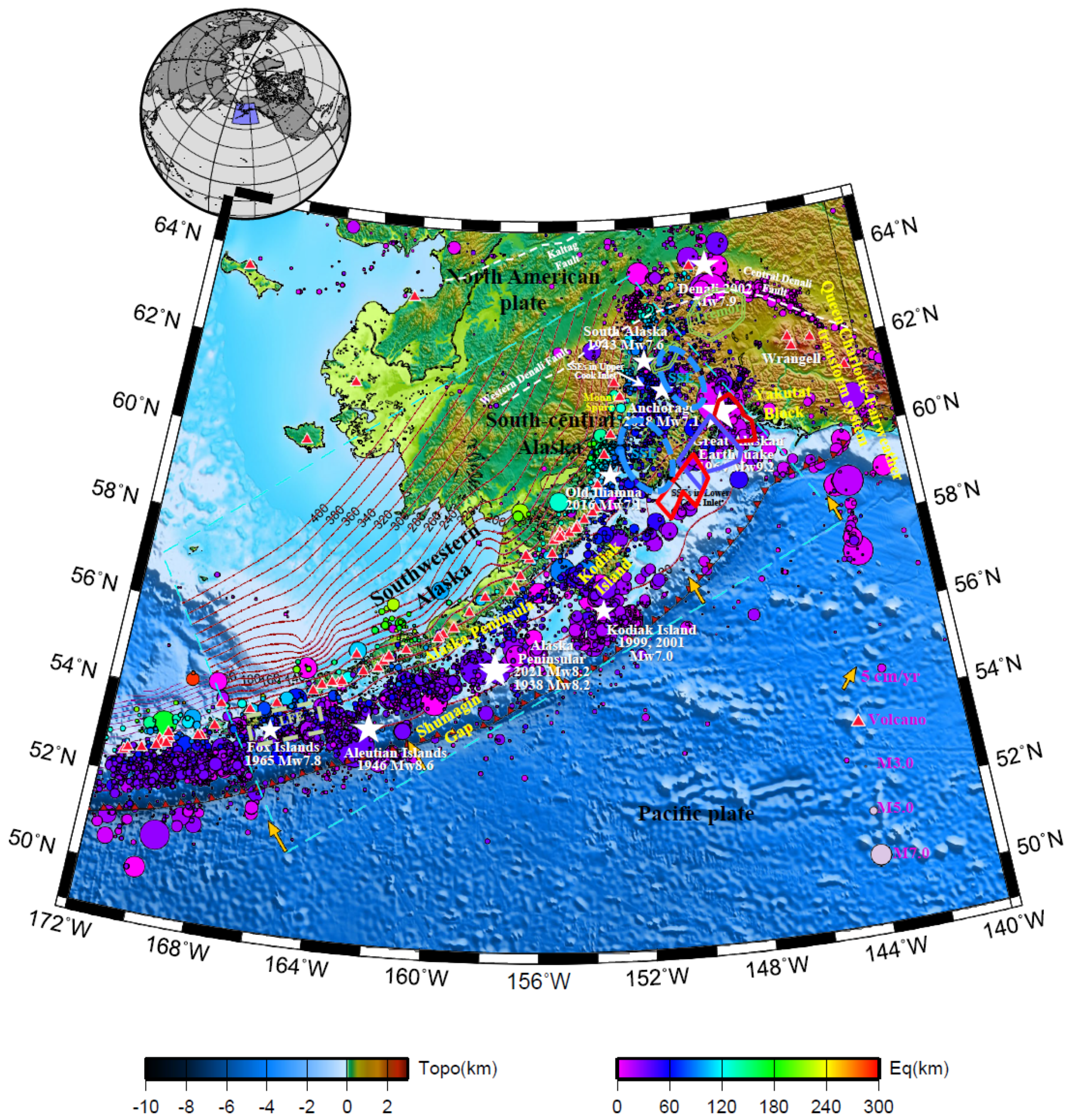
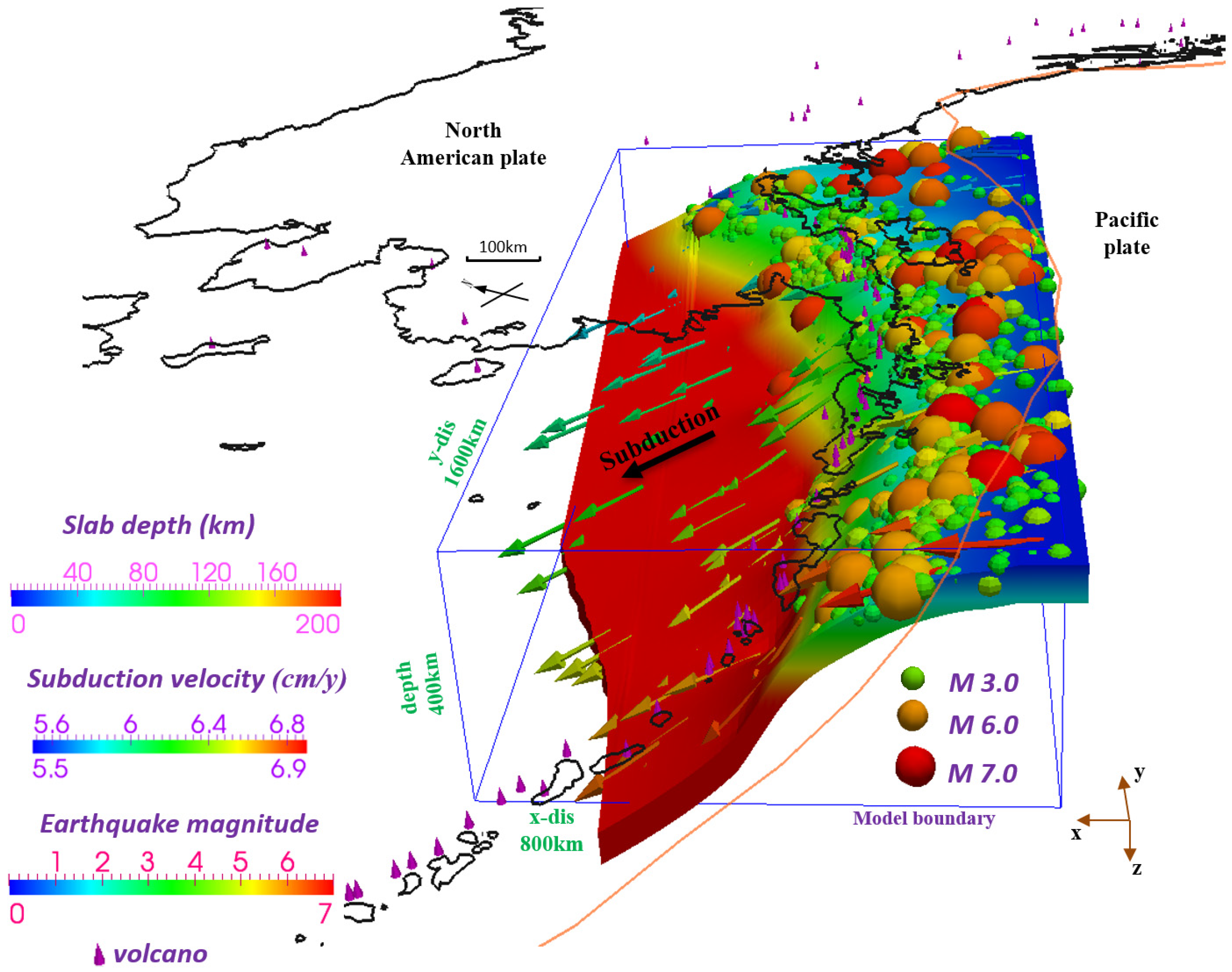
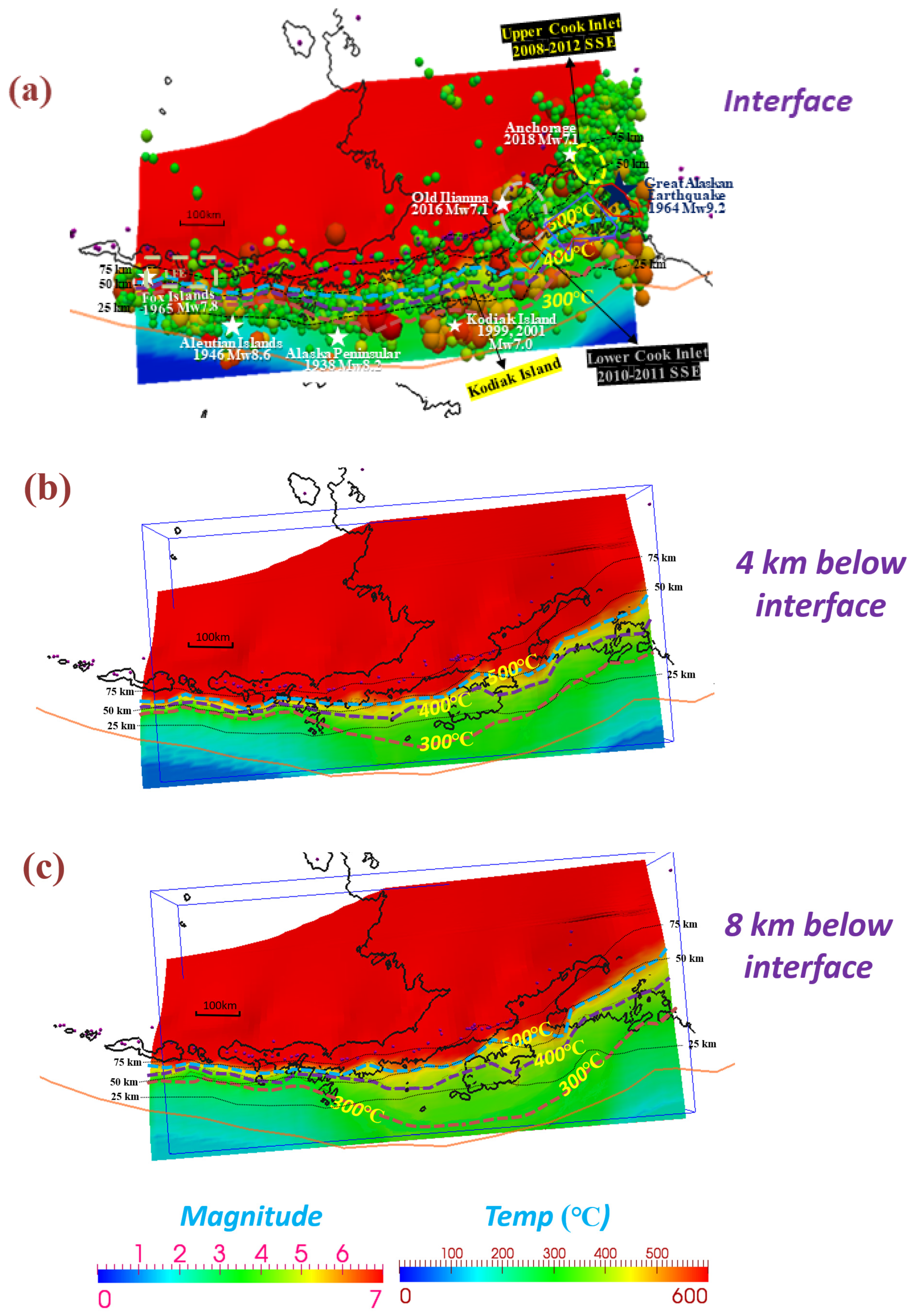
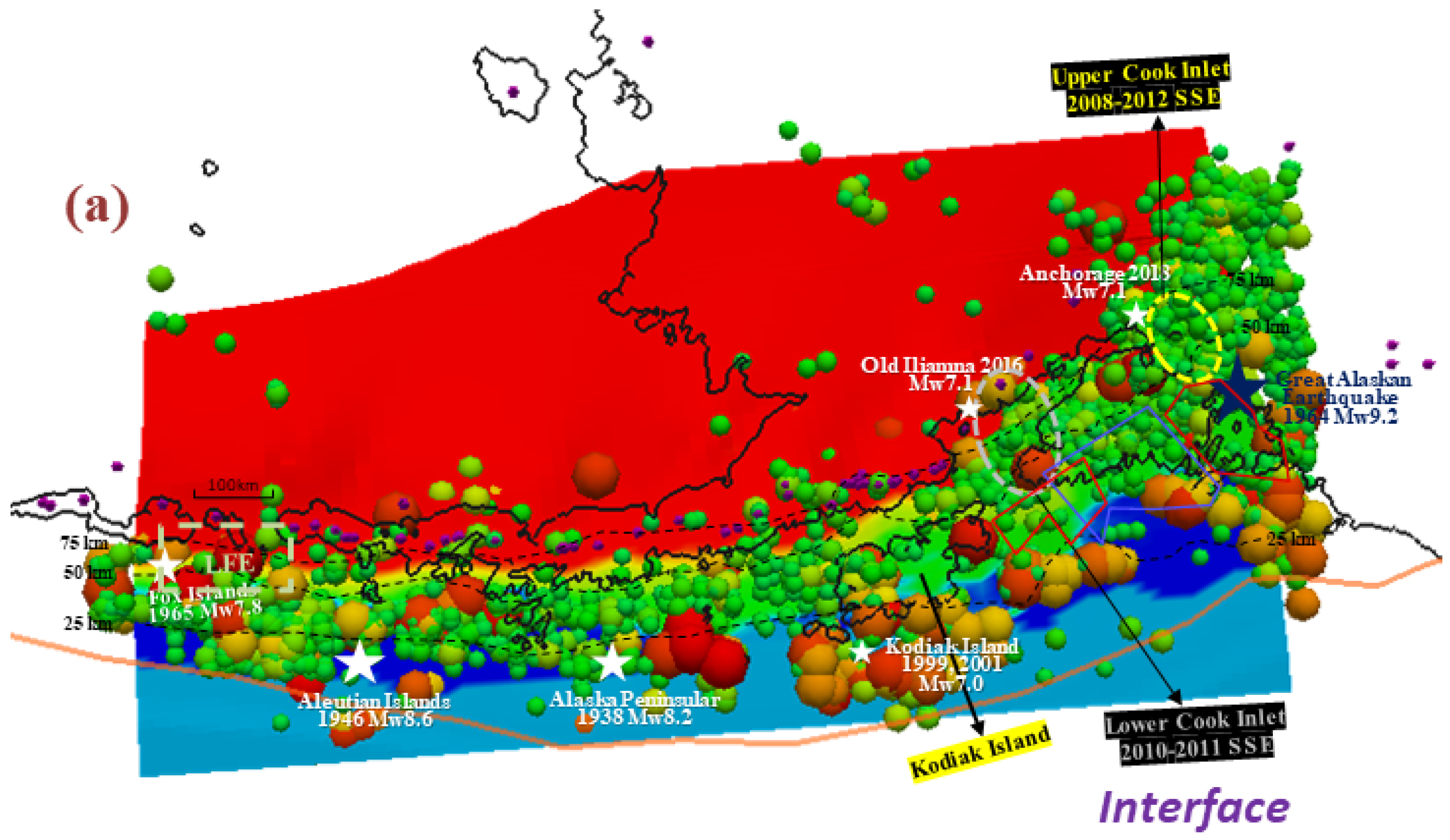
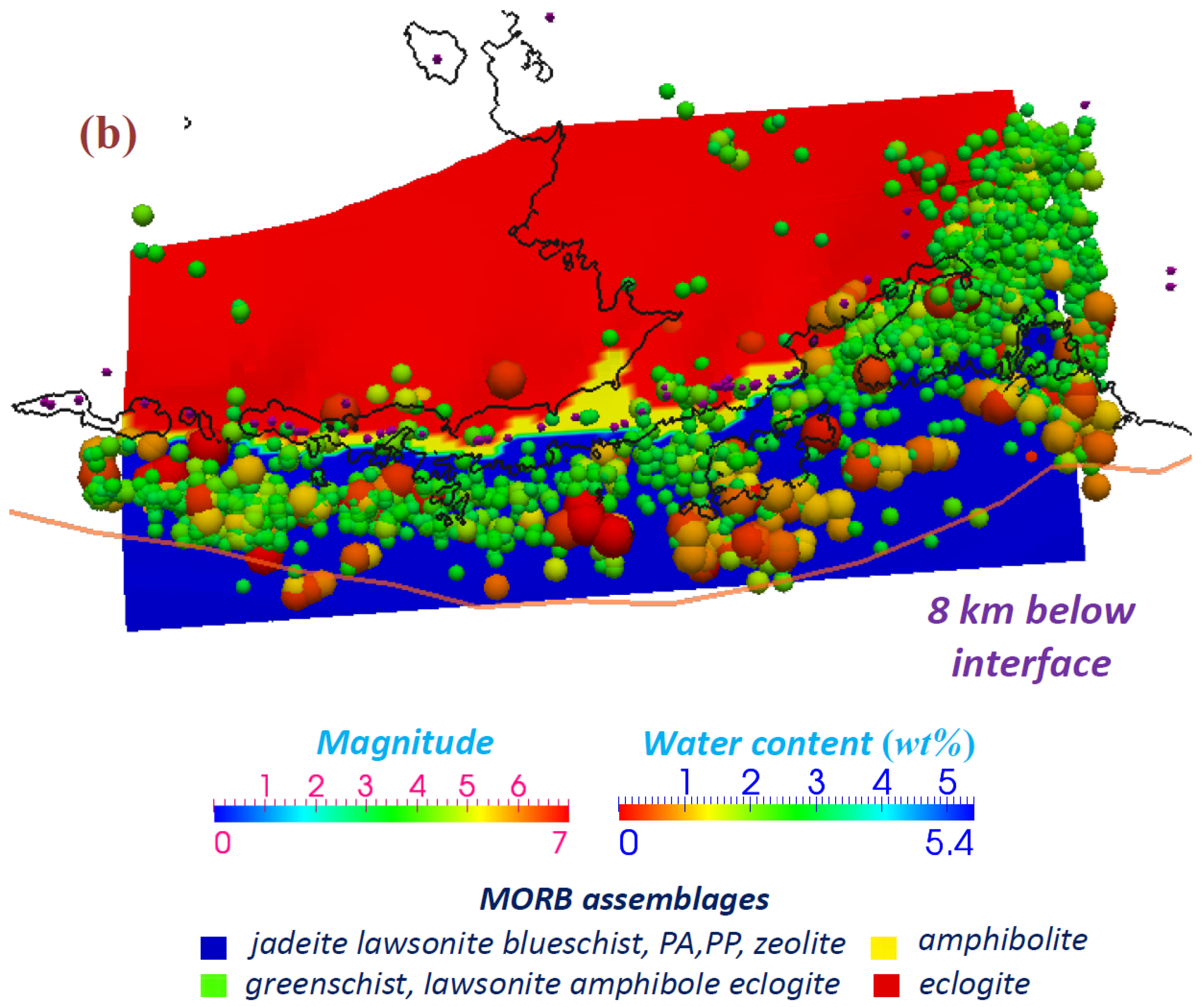
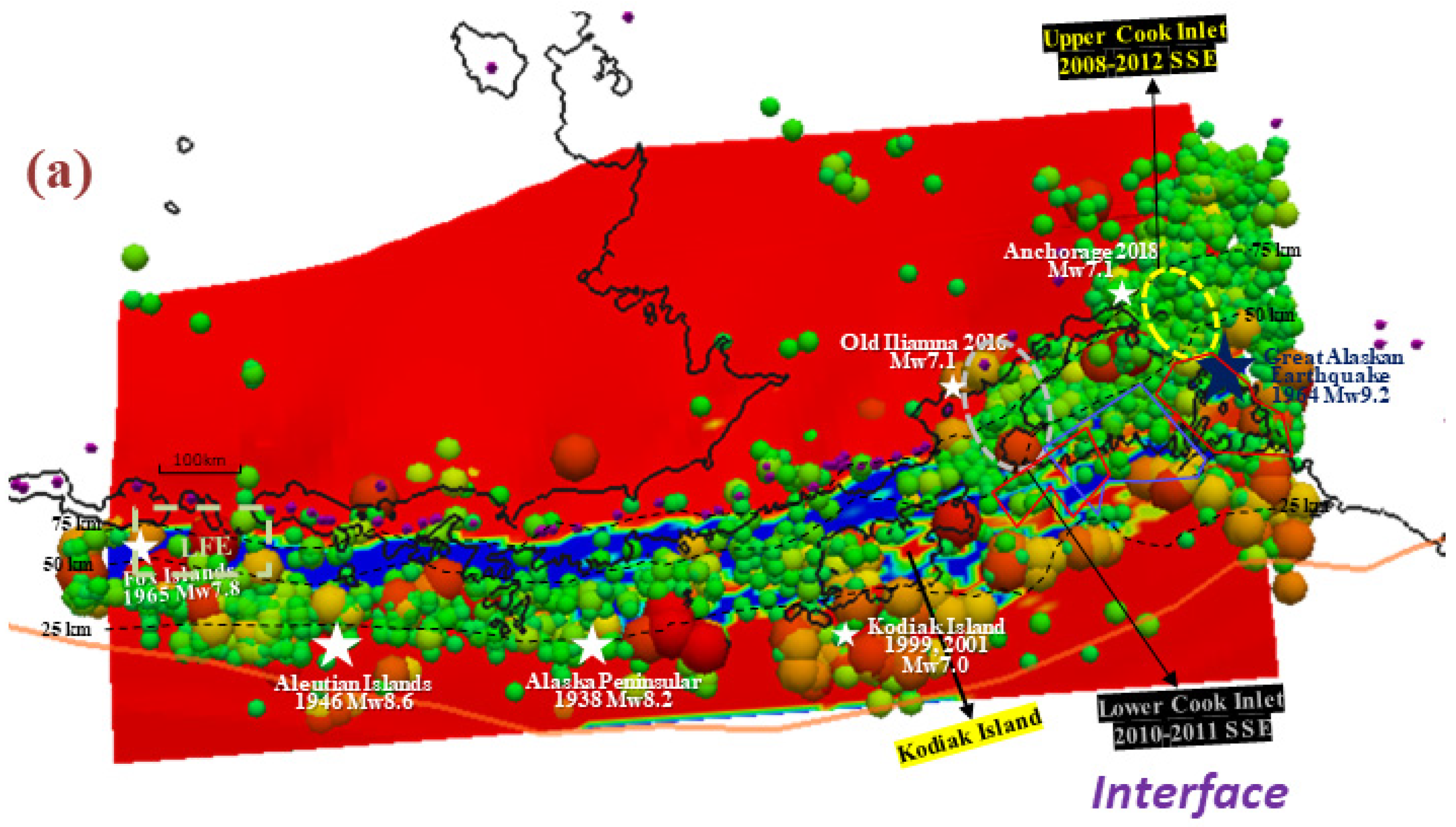
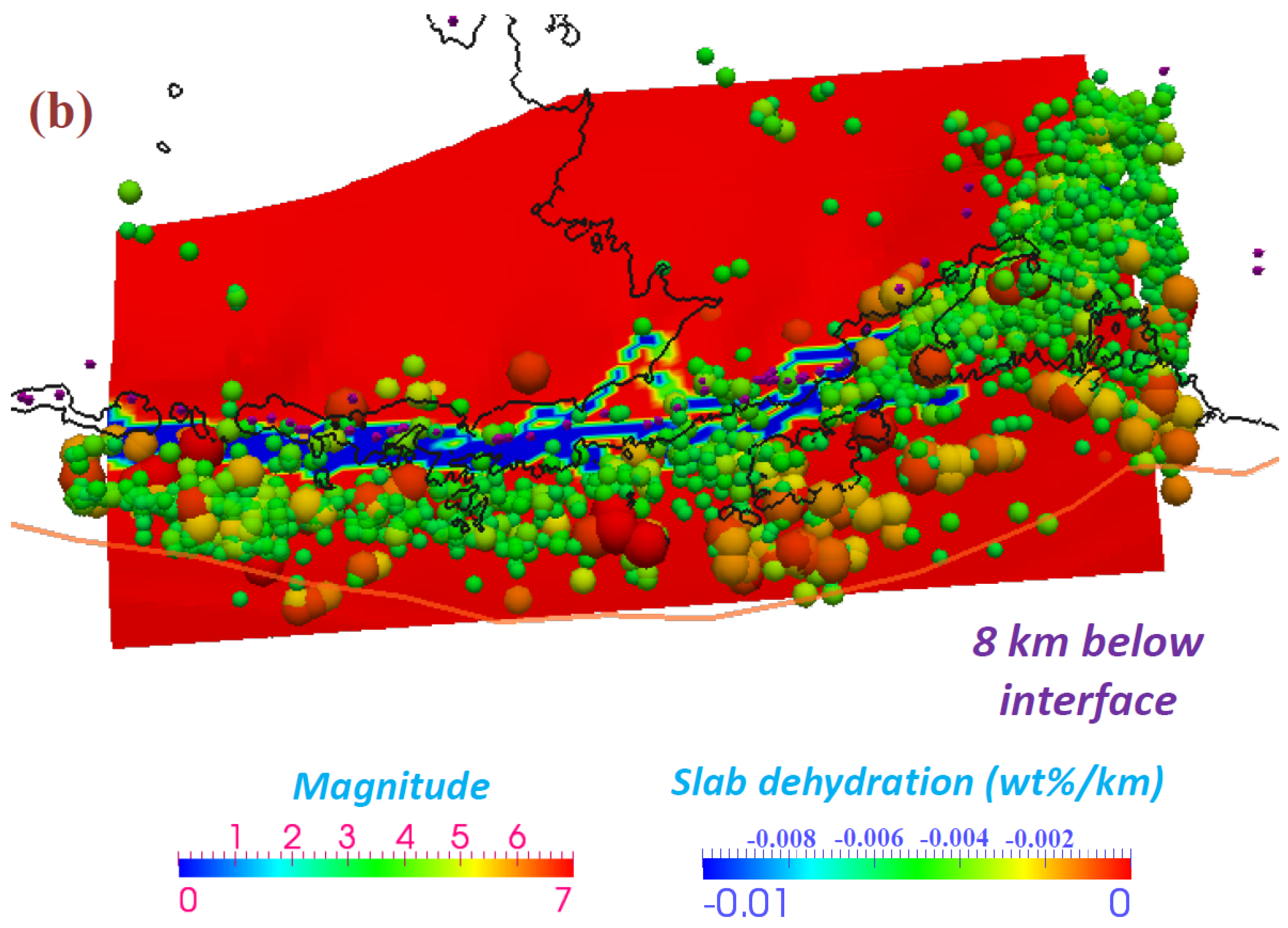
Publisher’s Note: MDPI stays neutral with regard to jurisdictional claims in published maps and institutional affiliations. |
© 2022 by the authors. Licensee MDPI, Basel, Switzerland. This article is an open access article distributed under the terms and conditions of the Creative Commons Attribution (CC BY) license (https://creativecommons.org/licenses/by/4.0/).
Share and Cite
Qu, R.; Ji, Y.; Zhu, W.; Zhao, Y.; Zhu, Y. Fast and Slow Earthquakes in Alaska: Implications from a Three-Dimensional Thermal Regime and Slab Metamorphism. Appl. Sci. 2022, 12, 11139. https://doi.org/10.3390/app122111139
Qu R, Ji Y, Zhu W, Zhao Y, Zhu Y. Fast and Slow Earthquakes in Alaska: Implications from a Three-Dimensional Thermal Regime and Slab Metamorphism. Applied Sciences. 2022; 12(21):11139. https://doi.org/10.3390/app122111139
Chicago/Turabian StyleQu, Rui, Yingfeng Ji, Weiling Zhu, Youjia Zhao, and Ye Zhu. 2022. "Fast and Slow Earthquakes in Alaska: Implications from a Three-Dimensional Thermal Regime and Slab Metamorphism" Applied Sciences 12, no. 21: 11139. https://doi.org/10.3390/app122111139
APA StyleQu, R., Ji, Y., Zhu, W., Zhao, Y., & Zhu, Y. (2022). Fast and Slow Earthquakes in Alaska: Implications from a Three-Dimensional Thermal Regime and Slab Metamorphism. Applied Sciences, 12(21), 11139. https://doi.org/10.3390/app122111139





